The big perennials are becoming more popular all the time. Most of these spectacular plants shoot up to two metres or more and make tall spire-like flower heads, but not all kinds have this spire structure. Most of these flowers are true perennials, lasting many years, others are short-lived perennials or even biennials which die after the effort of flowering. They all die back to a resting clump or rosette of leaves. The fact that they die back means their show is seasonal and speaks of lush summer borders.
One of the most popular is the golden oats grass, Stipa gigantea, which has a clump of knee-high leaves from which the flowers heads emerge in early summer and shoot up to two metres or so. Later, the oat-like seed heads dry out and remain until the tall stems are broken by autumn gales. The cardoon and the related cotton thistle are often grown for their woolly leaves – the latter almost white – and their purple thistle flower heads. The spiny stems might seem threatening and these plants should be placed away from the edge of a border, for height reasons too perhaps.
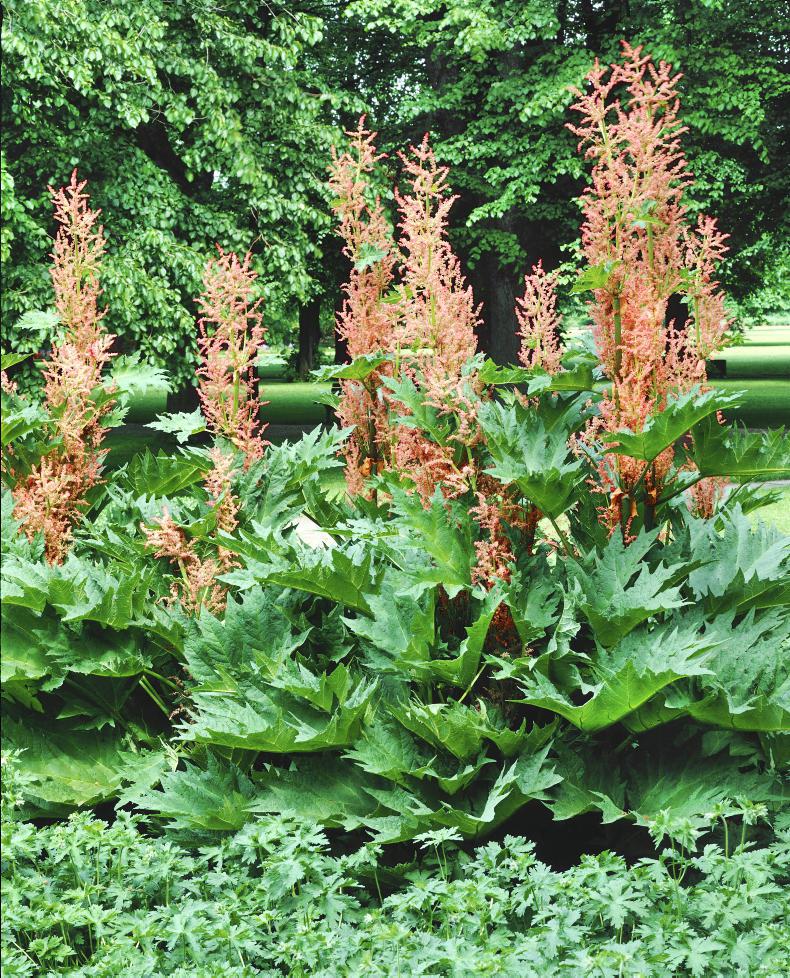
Ornamental rhubarb.
The plume poppy, Macleaya cordata, is another tall-growing perennial flower, the soft stems racing up to well over two metres, sometimes three metres, making airy heads of tiny flowers. The foliage of this plant is especially lovely with its shades of brown flushing through its grey green. The large forms of miscanthus, such as Miscanthus sacchariflorus, have stems like bamboo and are often confused as such. They can reach to three metres and form a formidable clump, a wall of greenery that turns brown in winter.
The meadow rues, or thalictrums, can make dramatically tall plants. Thalictrum delavayii has pale purple flowers in a loose and airy flower head of tiny flowers, a lovely effect. The yellow meadow rue, Thalictrum flavum, has more grouped heads of yellow flowers, also lovely. The height of these varies, but can easily reach two metres in rich moist soil, and where neighbouring plants force the thalictrum upwards. Another lovely yellow flower is the giant scabious, Cephalaria gigantea, bearing large pale yellow, scabious type flowers over a long period in summer. The Himalayan rhubarb, Rheum australe, has large rounded red-tinged leaves and a flower spike that can reach to three metres in good conditions. The Chinese rhubarb, Rheum palmatum, has large rhubarb-like leaves too, but with a jagged edge to the leaves, and there are purple-green forms. These species die back completely in winter in the same way as ordinary rhubarb.
The large Canary Island borage, Echium pininana, has been popular for years now, sending up a rocket spire of rich blue flowers in its second or third year after forming a big rosette of leaves and dying afterwards but shedding masses of seeds. Foxglove is also biennial or short-lived perennial and can be used to give tall spires of flowers, arising from rosettes of large leaves and it does well in slightly shady conditions, growing taller when drawn up by lack of light. On gravelly soil in full sunshine, the verbascums such as Verbascum bombyciferum have magnificent large felted silvery leaves in rosettes followed by tall spires of yellow flowers, and these are generally biennial or last only a few years.
But do not be tempted to use more than one, two or three of these kinds, in a few clumps – a garden can have too much drama and it is the contrast and balance of smaller perennials with shrubs, trees and the large perennial flowers that creates the interest.
If you have not managed to sow some sweet pea seeds, you can always buy plants which are readily available. It is essential to keep them growing. If they get any setback, or even slow down in growth, which can be due to cold weather, sweet peas often go to flower and grow very little more. Planting into rich, well-prepared soil is a good start.
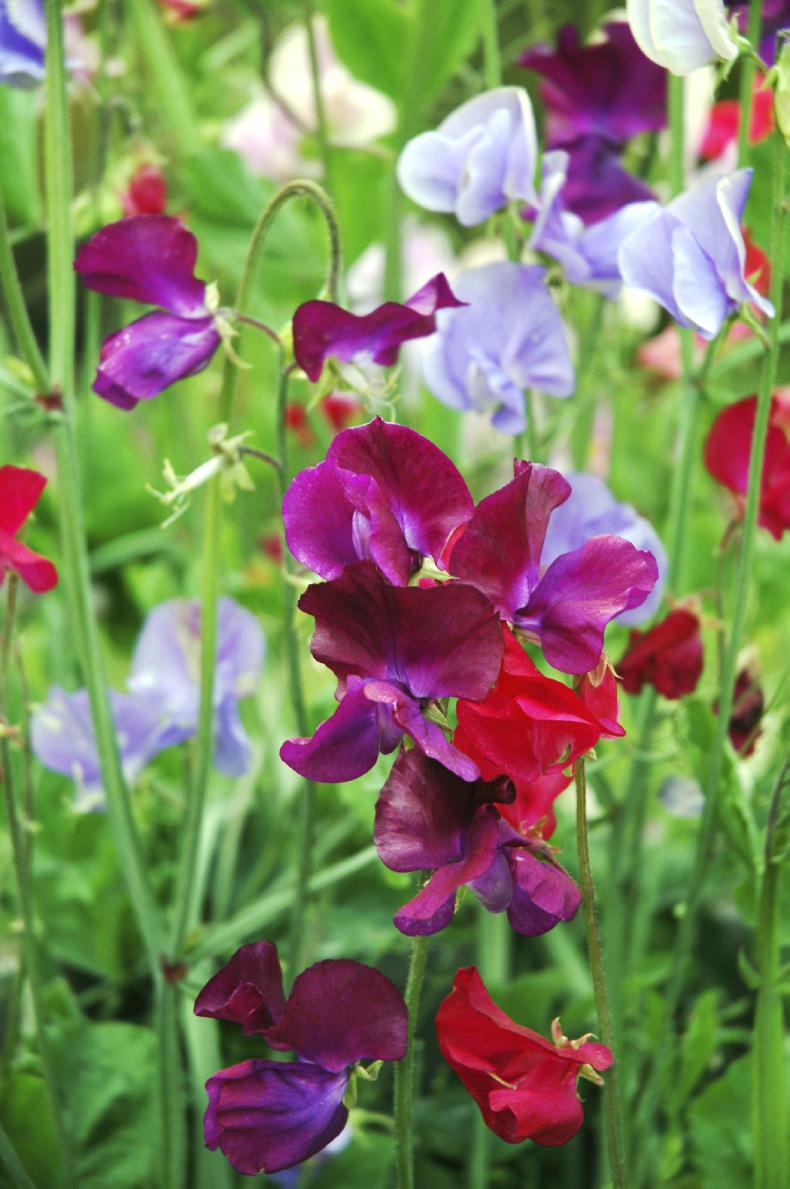
Sweet pea.
Make sure that they do not dry out during windy weather. Going further and giving some liquid feeding will help to keep things moving. The bigger the plants are before flowering begins, the bigger the show of flowers that will eventually be produced, but it is possible to overdo watering and cause the plants to be too leafy and the flowers to wither without opening.
Trees, shrubs and roses
After the most wonderful flowering of spring trees and shrubs, due to the hot summer, growth has been slow for a time. New plants are not showing active extension growth at the tips of the branches, and they may be suffering. Watch for drought too – later on, new shrubs and trees can suffer when a dry spell comes. Prune early flowering shrub roses and ramblers.
Fruit, vegetables and herbs
A late crop of carrots could be sown, and will give carrots late in the year if the weather is good. Sow more of the salad vegetables that mature quickly. Peas could still be sown but are unlikely to give much unless weather conditions suit them. Plant out winter cabbage varieties if not already done. Use vegetables as soon as they are of useable size to avoid gluts later.
Lawns
Many lawns are looking poor because of the stop-start growing conditions. Many lawns look hungry and should be fed. If the grass is green, leave it be for a while. However, even lawns fed earlier in the year could probably benefit from a second feed now, and certainly those that did not get fertiliser in the spring should be fed now. Do not feed a wildflower lawn.
Flowers
There is still time to plant bedding plants in pots or in the open ground. Bedding plants in pots and baskets are now in need of regular watering and feeding. Because the roots have filled the pots, watering has become more critical. Feeding every two weeks or so will keep the plants going after the first flush. Sow seeds of perennial flowers such as lupins and foxgloves for next year.
Greenhouse and house plants
Continue watering and feeding all greenhouse plants and house plants. Water plants in pots or grow-bags regularly because these can easily dry out. Train and side-shoot tomatoes and cucumbers. Take cuttings of all kinds – especially roses and clematis now. A greenhouse can be used to grow warm climate plants, begonias, cannas and alstroemeria, that luxuriate in the heat.
Read more
In the garden with Gerry Daly: Hardy geraniums
In the garden with Gerry Daly: sunny roses
The big perennials are becoming more popular all the time. Most of these spectacular plants shoot up to two metres or more and make tall spire-like flower heads, but not all kinds have this spire structure. Most of these flowers are true perennials, lasting many years, others are short-lived perennials or even biennials which die after the effort of flowering. They all die back to a resting clump or rosette of leaves. The fact that they die back means their show is seasonal and speaks of lush summer borders.
One of the most popular is the golden oats grass, Stipa gigantea, which has a clump of knee-high leaves from which the flowers heads emerge in early summer and shoot up to two metres or so. Later, the oat-like seed heads dry out and remain until the tall stems are broken by autumn gales. The cardoon and the related cotton thistle are often grown for their woolly leaves – the latter almost white – and their purple thistle flower heads. The spiny stems might seem threatening and these plants should be placed away from the edge of a border, for height reasons too perhaps.

Ornamental rhubarb.
The plume poppy, Macleaya cordata, is another tall-growing perennial flower, the soft stems racing up to well over two metres, sometimes three metres, making airy heads of tiny flowers. The foliage of this plant is especially lovely with its shades of brown flushing through its grey green. The large forms of miscanthus, such as Miscanthus sacchariflorus, have stems like bamboo and are often confused as such. They can reach to three metres and form a formidable clump, a wall of greenery that turns brown in winter.
The meadow rues, or thalictrums, can make dramatically tall plants. Thalictrum delavayii has pale purple flowers in a loose and airy flower head of tiny flowers, a lovely effect. The yellow meadow rue, Thalictrum flavum, has more grouped heads of yellow flowers, also lovely. The height of these varies, but can easily reach two metres in rich moist soil, and where neighbouring plants force the thalictrum upwards. Another lovely yellow flower is the giant scabious, Cephalaria gigantea, bearing large pale yellow, scabious type flowers over a long period in summer. The Himalayan rhubarb, Rheum australe, has large rounded red-tinged leaves and a flower spike that can reach to three metres in good conditions. The Chinese rhubarb, Rheum palmatum, has large rhubarb-like leaves too, but with a jagged edge to the leaves, and there are purple-green forms. These species die back completely in winter in the same way as ordinary rhubarb.
The large Canary Island borage, Echium pininana, has been popular for years now, sending up a rocket spire of rich blue flowers in its second or third year after forming a big rosette of leaves and dying afterwards but shedding masses of seeds. Foxglove is also biennial or short-lived perennial and can be used to give tall spires of flowers, arising from rosettes of large leaves and it does well in slightly shady conditions, growing taller when drawn up by lack of light. On gravelly soil in full sunshine, the verbascums such as Verbascum bombyciferum have magnificent large felted silvery leaves in rosettes followed by tall spires of yellow flowers, and these are generally biennial or last only a few years.
But do not be tempted to use more than one, two or three of these kinds, in a few clumps – a garden can have too much drama and it is the contrast and balance of smaller perennials with shrubs, trees and the large perennial flowers that creates the interest.
If you have not managed to sow some sweet pea seeds, you can always buy plants which are readily available. It is essential to keep them growing. If they get any setback, or even slow down in growth, which can be due to cold weather, sweet peas often go to flower and grow very little more. Planting into rich, well-prepared soil is a good start.

Sweet pea.
Make sure that they do not dry out during windy weather. Going further and giving some liquid feeding will help to keep things moving. The bigger the plants are before flowering begins, the bigger the show of flowers that will eventually be produced, but it is possible to overdo watering and cause the plants to be too leafy and the flowers to wither without opening.
Trees, shrubs and roses
After the most wonderful flowering of spring trees and shrubs, due to the hot summer, growth has been slow for a time. New plants are not showing active extension growth at the tips of the branches, and they may be suffering. Watch for drought too – later on, new shrubs and trees can suffer when a dry spell comes. Prune early flowering shrub roses and ramblers.
Fruit, vegetables and herbs
A late crop of carrots could be sown, and will give carrots late in the year if the weather is good. Sow more of the salad vegetables that mature quickly. Peas could still be sown but are unlikely to give much unless weather conditions suit them. Plant out winter cabbage varieties if not already done. Use vegetables as soon as they are of useable size to avoid gluts later.
Lawns
Many lawns are looking poor because of the stop-start growing conditions. Many lawns look hungry and should be fed. If the grass is green, leave it be for a while. However, even lawns fed earlier in the year could probably benefit from a second feed now, and certainly those that did not get fertiliser in the spring should be fed now. Do not feed a wildflower lawn.
Flowers
There is still time to plant bedding plants in pots or in the open ground. Bedding plants in pots and baskets are now in need of regular watering and feeding. Because the roots have filled the pots, watering has become more critical. Feeding every two weeks or so will keep the plants going after the first flush. Sow seeds of perennial flowers such as lupins and foxgloves for next year.
Greenhouse and house plants
Continue watering and feeding all greenhouse plants and house plants. Water plants in pots or grow-bags regularly because these can easily dry out. Train and side-shoot tomatoes and cucumbers. Take cuttings of all kinds – especially roses and clematis now. A greenhouse can be used to grow warm climate plants, begonias, cannas and alstroemeria, that luxuriate in the heat.
Read more
In the garden with Gerry Daly: Hardy geraniums
In the garden with Gerry Daly: sunny roses







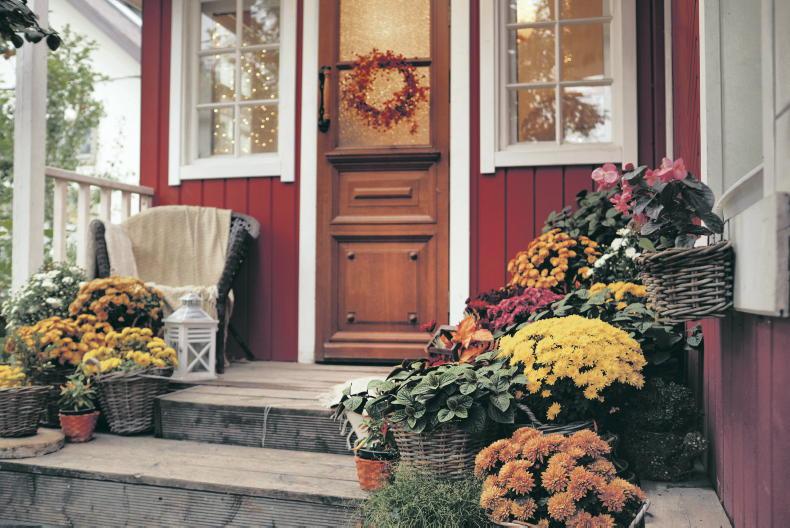
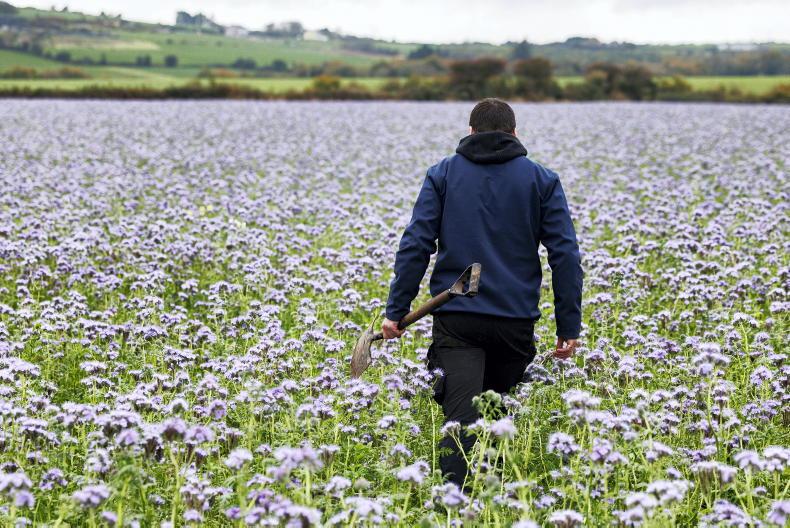
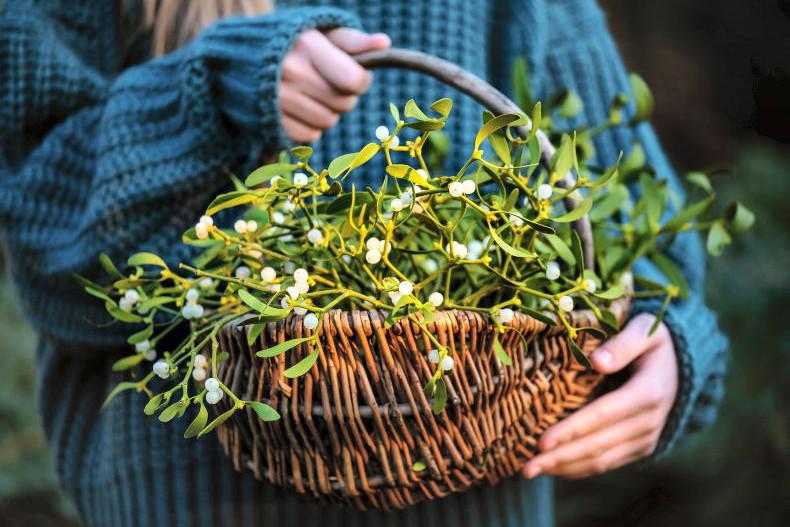
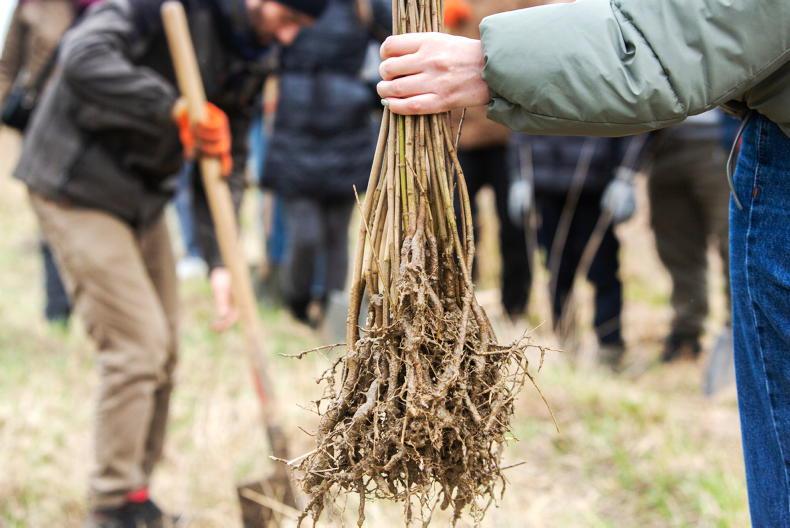
SHARING OPTIONS